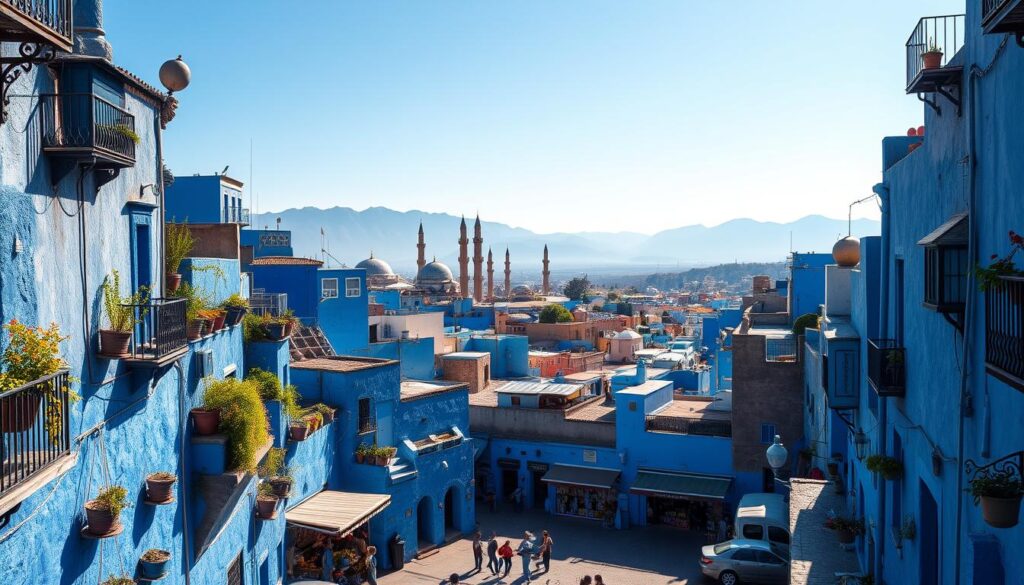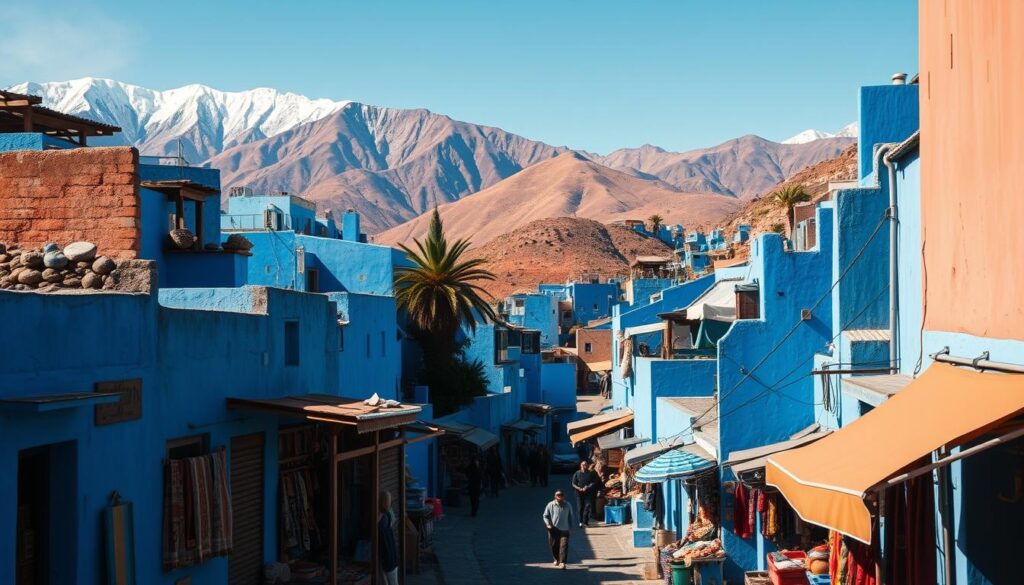Nestled in the Rif Mountains of northern Morocco, a city stands out for its breathtaking blue-washed buildings and winding streets, creating a dreamlike atmosphere that captivates travelers and photographers alike.
This enchanting town, often referred to as Morocco’s “Blue Pearl,” offers more than just visual beauty; it provides a rich cultural experience blending Moroccan, Andalusian, and Jewish influences.
Unlike other bustling Moroccan cities, this hidden gem invites visitors to wander through its serene blue streets, interact with locals, and absorb the peaceful mountain atmosphere, making it an ideal destination for those seeking an authentic travel experience.
Key Takeaways
- Discover the unique charm of Morocco’s Blue City.
- Explore the rich cultural heritage of Chefchaouen.
- Experience the serene atmosphere of this mountain town.
- Learn practical tips for planning your trip.
- Uncover the history behind the city’s blue-washed buildings.
Discovering Chefchaouen: Morocco’s Enchanting Blue City
In the heart of Morocco lies Chefchaouen, a charming town that has captivated visitors with its blue-hued architecture. This picturesque town, nestled in the Rif Mountains, is a treasure trove of history, culture, and natural beauty.
The History of Chefchaouen
Chefchaouen’s history is as colorful as its buildings. Founded in 1471, the town has been a refuge for various cultures, including the Sephardic Jewish community who brought with them their traditions and customs. This diverse heritage is still palpable in the town’s architecture, cuisine, and the warmth of its locals.
| Year | Event | Significance |
|---|---|---|
| 1471 | Foundation of Chefchaouen | Marked the beginning of the town’s rich history |
| Late 15th Century | Sephardic Jewish community settles | Introduced the tradition of painting buildings blue |
| World War II | Jewish refugees flee to Chefchaouen | Reinforced the blue-painting tradition |
Why is Chefchaouen Blue?
The town’s signature blue color has sparked numerous theories. One explanation is that the Sephardic Jewish community painted buildings blue to remind them of the sky and the presence of God. Another theory suggests that the blue color was used to repel mosquitoes and prevent malaria. Regardless of its origins, the tradition has been maintained by locals who take pride in their city’s unique appearance.

The various shades of blue create a mesmerizing effect as you walk through the city, with the colors shifting throughout the day as the sunlight changes. This makes shops and ordinary streets appear magical to visitors, embodying a living tradition that is quintessentially Chefchaouen.
Top Things to Do in Chefchaououen (Blue City)
With its picturesque landscapes and rich history, Chefchaouen is a destination that promises an unforgettable adventure. Visitors can immerse themselves in a variety of activities that showcase the best of this Moroccan city.
Exploring the Blue Medina
The Blue Medina of Chefchaouen is a photographer’s paradise, with its blue-painted buildings and narrow streets that invite exploration. As you wander through the medina, you’ll discover local artisans, charming cafes, and historic landmarks that reflect the city’s rich cultural heritage. It’s a great way to spend a leisurely day, soaking up the atmosphere and interacting with the friendly local people.
Visiting the Kasbah and Ethnography Museum
The Kasbah, or old fortress, is another must-visit attraction in Chefchaouen, housing the Ethnography Museum. The museum offers insights into the region’s history and culture, with exhibits on local traditions, crafts, and the history of the Rif region. It’s an excellent way to gain a deeper understanding of the area‘s heritage.
Hiking in the Rif Mountains
For those seeking adventure, the Rif Mountains surrounding Chefchaouen offer numerous hiking trails for all skill levels. A popular hike is to the Spanish Mosque, which provides breathtaking views of the city and the surrounding landscape. You can embark on a challenging day-long trek or a more leisurely stroll, enjoying the natural beauty and possibly encountering local Berber communities going about their daily lives.
Planning Your Visit to Chefchaouen
Chefchaouen, with its mesmerizing blue hues, is a destination that requires some planning to fully appreciate. To make the most of your trip, it’s essential to consider the best time to visit, how to get there, and how to navigate the city.
Best Time to Visit Chefchaouen
The best time to visit Chefchaouen is during the spring (March to May) or autumn (September to November), when the weather is mild and pleasant. These periods are ideal for hiking in the Rif Mountains and exploring the blue medina without the harsh summer heat or cold winter chill.
Visiting in the morning is recommended, as the city is less crowded, and you can observe locals going about their daily routines.
How to Get to Chefchaouen
Chefchaouen is accessible by bus or taxi from major cities like Tangier and Tetouan. The nearest airport is in Tangier, from where you can take a bus or hire a private transfer to Chefchaouen. Planning your transport in advance ensures a smooth journey.
- Bus services connect Chefchaouen to major cities, offering a convenient and relatively affordable option.
- Taxis are available for a more direct, though pricier, journey.
- For those driving, Chefchaouen is reachable via the N2 highway from Tangier or Tetouan.
Getting Around the Blue City
The compact size of Chefchaouen makes it easy to explore on foot. The blue medina is pedestrianized, and most attractions are within walking distance. Comfortable shoes are a must due to the medina’s hilly terrain and numerous stairs.

- Walking is the best way to experience the city’s charm and discover hidden gems.
- Taxis are available for trips to outlying areas or for those with mobility concerns.
By planning ahead, you can enjoy a hassle-free visit to this enchanting blue city.
Where to Stay and Eat in Chefchaouen
Chefchaouen’s charm lies not only in its blue medina but also in its warm hospitality and delectable food, making the choice of where to stay and eat vital.
Recommended Riads and Hotels
Choosing the right place to stay in Chefchaouen can significantly enhance your travel experience. The city offers a variety of riads and hotels that cater to different preferences and budgets.
For a truly immersive experience, consider staying in a riad. These traditional Moroccan houses with interior gardens offer a serene ambiance and a glimpse into local culture. Many riads in Chefchaouen are located in the heart of the medina, providing easy access to its main attractions.
Top Restaurants and Cafés
Chefchaouen’s dining scene is a blend of traditional Moroccan cuisine and international flavors, offering something for every palate. Many restaurants feature terraces with stunning views over the blue-washed buildings, making dining a memorable experience.
Bab Ssour stands out as a local favorite for authentic Moroccan dishes at reasonable prices. It’s an ideal place for lunch or dinner, with communal tables where travelers can share meals with locals and visitors from around the world.
For a unique dining experience, consider La Lampe Magique Casa Aladin, which offers a rooftop view of the city. The alfresco dining area provides a spectacular view of the surrounding riads and the blue city, especially at night.
The cafés around Plaza Uta el-Hammam are perfect for breakfast or a morning coffee, offering prime people-watching opportunities as the medina comes to life. Many serve traditional Moroccan mint tea and fresh pastries, providing a delightful start to the day.
Essential Tips for an Unforgettable Chefchaouen Experience
As you wander through Chefchaouen’s blue-hued streets, the experience is nothing short of enchanting. To make the most of your visit to this blue city, consider the following tips.
For the best photo opportunities, visit in the early morning when the soft light enhances the blue tones and the streets are relatively empty. This allows for unobstructed shots of the city’s architecture and doorways.
When exploring the medina, be prepared for shop owners to invite you to view their goods. A polite “La, shukran” (no, thank you) is usually respected if you’re not interested. Additionally, respect local customs by dressing modestly, especially when visiting religious sites, and always ask permission before photographing local people.
The city takes on a magical quality at different times of day – the bright blues under midday sun, the golden hues at sunset reflecting on blue walls, and the mysterious deep blues that emerge in the evening under the night sky. Consider staying at least one night in Chefchaouen to experience the morning and evening atmospheres, which are distinctly different from the midday hours when tour groups typically visit.
For an authentic experience, venture away from the main tourist streets to find smaller shops and local cafés. Be aware of local laws and customs, especially regarding marijuana cultivation in the surrounding mountain areas.